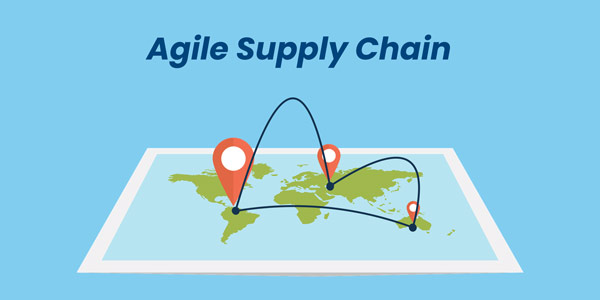How Can Supply Chain Diversification Mitigate the Risks
- Date:
- Author: SVI Content Team
- Share:

Unexpected factors can have a significant impact on businesses. Recent years are proof positive, with examples such as the U.S.-China trade dispute and the COVID-19 outbreak. The pandemic sweeping the globe has brought the economy to a near standstill, forcing companies to re-evaluate their strategies.
In the manufacturing sector, a growing number of companies are recognizing the importance of diversifying their supply chains in response to such disruptions. Relying on only limited regions or suppliers can put a company in a precarious position, like a raft adrift in the ocean.
Embracing a diverse supply chain can bring many benefits. In the following sections, we will take a look at the strategy of supply chain diversification in depth, and stress its significance and advantages for your best understanding. Without further ado, let’s move on.
Part 1. What Is Supply Chain Diversification?
Supply chain diversification, in the context of manufacturing businesses, refers to the strategic approach of engaging more than one supplier in sourcing to provide goods or services in multiple countries or regions.
Why Do You Need to Diversify the Supply Chain?
The supply chain encompasses all processes from sourcing raw materials to delivering the final product to the customer. It is a key link in turning ideas into reality and generating profits. If one link breaks, the entire chain suffers.
Reliance on a single supplier or region exposes companies to higher risk. The recent complex global trade events have shown how fragile concentrated supply chains can be. In the current market, the trend is to build a resilient and reliable supply chain.
Applying supply chain diversification strategies not only helps maintain stability but also provides numerous benefits, such as mitigating risks, improving agility, and gaining a competitive advantage in the market.
As a worldwide sourcing partner, SVI Global is well-equipped in this regard, with headquarters in the United States and offices in East Asia, Southeast Asia and Latin America. We have extensive knowledge of suppliers, manufacturers and logistics services in different countries. Whether offshore or nearshore outsourcing, SVI Global is committed to managing the supply chain efficiently while ensuring product quality.
Need Help for Your Sourcing Project?
Let SVI Global find the right suppliers and manage your project.
We guarantee quality and on-time delivery!
Part 2. What Are the Benefits of Supply Chain Diversification?
Why would a business want to make sure that its supply chain is diverse? That’s because it brings advantages beyond just risk management. Here are the key benefits of supply chain diversification:
1. Improve Companies' Resilience
One of its pros is that a diversified supply chain can enhance the resilience of a company.
By collaborating with different suppliers, manufacturers, etc., the company can minimize the impact of relying heavily on a limited suppliers.
In this case, companies can manage their supply chains continually and maintain stability if they encounter disruptions.
2. Reduce Potential Risks
Disruptions such as natural disasters, geopolitical issues, or trade disputes can severely impact the supply chain.
Diversification in supply chain management can spread sourcing across multiple suppliers, regions or countries. If one source is affected, companies can still work with alternative sources, which helps mitigate the potential risk.
3. Optimize Business Costs
Diversification allows you to compare suppliers, negotiate better deals, and even shift production to lower-tariff regions based on the global trend.
It reduces the risk of price fluctuations or sudden cost increases associated with depending on a single supplier.
For example, the imposition of increased taxes and tariffs between China and the US can significantly burden business costs. However, if a company has suppliers from other countries, such as Mexico, it can mitigate these costs by manufacturing products with alternative manufacturers and shortening the logistics time. This diversification strategy not only helps control expenses but also improves operational efficiency, ultimately contributing to improved cost-effectiveness for the business.
4. Expand Market Access
There are different types of supply chain diversification strategies, such as supplier diversification and geographic diversification.
Geographic diversification in supply chain involves choosing the sourcing and manufacturing locations in various regions, enabling companies to access local or nearby markets more easily.
This approach allows businesses to expand their geographical reach, gain market share, and establish proximity to customers, thus enhancing their ability to adapt to market demands.
5. Incentivize Innovation
Supply chain management provides organizations with the opportunity to tap into talent from various regions and industries.
Diversity in the supply chain allows companies to access a wide range of ideas by collaborating with different suppliers who bring unique perspectives, expertise, and advanced technologies.
Part 3. Challenges of Having Diversification in Supply Chain Management
While the benefits are clear, diversification of supply chains also comes with challenges importers must take into account:
1. Higher Initial Costs
Setting up multiple supplier relationships requires companies with resources and investments that could support factory audits and product inspections, contracts, and new logistics arrangements.
2. Supply Chain Management Burden
Managing suppliers across regions adds layers of coordination, increasing administrative burden. It needs companies to be familiar and professional in the industry to ensure the management go well.
3. Regulatory and Trade Barriers
Every region has different regulations, tariffs, and business practices. These differences can slow down operations if not managed well.
4. Inconsistent Quality Risks
Suppliers in different countries may follow different standards. Without strong oversight, product quality can vary. According to the QIMA survey, 65% of buyers who diversified their sourcing recently named product quality as a top challenge, especially when entering less established markets. Fluctuating quality can damage brand reputation and customer trust.
Part 4. Examples of Supply Chain Diversification Strategies
There are several notable examples of companies that have successfully spread partners across diverse regions to gain a competitive advantage in the evolving business environment.
Apple Inc.:
Forbes has illustrated Apple’s choice to diversify supply chains. Because of the lockdowns and geopolitical tensions in the world, companies that want to maintain their edge will start taking action to move or expand their supply chains out of the manufacturing giant, China. Apple Inc. is among the companies recognizing the need for diversification.
It has been relying on suppliers from China to produce its entire product lineup. However, this dependence on a single country has exposed Apple to vulnerabilities, particularly during the COVID-19 lockdowns. To mitigate these risks and ensure a consistent supply of products to customers, Apple has implemented a strategy of diversifying its supply chain across different regions.
Apple has taken the strategic decision to expand its manufacturing capabilities outside of China by producing iPhones in India and MacBooks in Vietnam. This approach has allowed Apple to reduce its reliance in individual countries and distribute its production across multiple locations, thereby increasing resilience and reducing potential disruptions in the supply chain.
Nike, Inc.:
Nike is a global leader in the sports footwear and apparel industry and has strategically diversified its supply chain to mitigate risks and enhance operational efficiency. It started to explore other countries to settle its supply chain before the pandemic, according to news from JustStyle. The regional diversity, expanding its distribution in North America (Los Angeles, Pennsylvania, Texas) and Europe (Madrid and Belgium), helps Nike deliver goods to customers faster to lessen the global effect. Moreover, Nike also involves working with multiple suppliers and manufacturers across different regions and countries.
For instance, Nike has expanded its manufacturing operations beyond traditional hubs like China and Vietnam. The company has increased its production in countries such as Indonesia, Cambodia, and Bangladesh. By diversifying its sourcing and manufacturing locations, Nike reduces its dependence on any single supplier or region, thereby minimizing the impact of disruptions such as natural disasters, political instability, or trade disputes.
FAQ on Supply Chain Diversification
Q1: How do you diversify your supply chain?
- Map and assess risks in current supply chain.
- Identify and vet alternative suppliers/regions.
- Pilot production runs with new partners in new markets.
- Build long-term supplier relationships.
- Audit, monitor and adjust regularly.
Q2: When should companies implement supply chain diversification strategies?
Supply chain diversification is not for every company. It is best suited for businesses where the risk and cost of a major disruption, like relying on a single geographic region or supplier, outweigh the significant investment and complexity of diversifying. Startups with small volumes may prioritize speed and cost first.
The time to implement this strategy is when warning signs appear, such as high concentration risk, increasing geopolitical tensions in your supply regions, or recurring disruptions that threaten operations. Ask yourself:
- Is our supply chain too dependent on one country or supplier for main products?
- Have the geopolitical or trade risks in our main sourcing regions increased?
- Are trade disputes, tariffs, or logistics delays affecting our operations and margins?
- What is the potential financial loss per day from a major supply halt?
- Do I need faster market access or lower risks?
- Do we have the budget for supply chain diversification?
- Do we have the internal expertise to manage a more complex supplier network?
Q3: What regions are best for supply chain diversification?
For U.S. buyers, Mexico offers nearshoring advantages. While Southeast Asia, including Vietnam, Thailand, and Indonesia, is attractive for lower costs and strong manufacturing bases.
Companies now commonly adopt a “China Plus One” strategy to spread risk across different geographical areas. The ideal choice is a portfolio of locations that balances goals like risk mitigation, cost reduction, and speed to market.
- Mexico (nearshoring): Shorter lead times, reduced tariffs, easier oversight.
Final Thoughts
Due to the shifting trend these years, the company now look for bets on multiple horses, learning the strategy of diversification in supply chain management. Supply chain diversification offers numerous benefits and strategic advantages for businesses. By having a diversified supply chain, companies can enhance their resilience, mitigate risks, optimize costs, adapt to market dynamics, incentivize innovation, and gain a competitive edge.
To get the best support with supply chains across borders, SVI Global can serve as an ideal partner for sourcing in various regions, collaborating with different suppliers and manufacturers. With our extensive supply chains spanning borders, we are well-equipped to assist you in building a diverse and inclusive supply chain. If you are interested in harnessing the advantages of diversification in supply chain, please feel free to contact us. We are glad to assist you!








